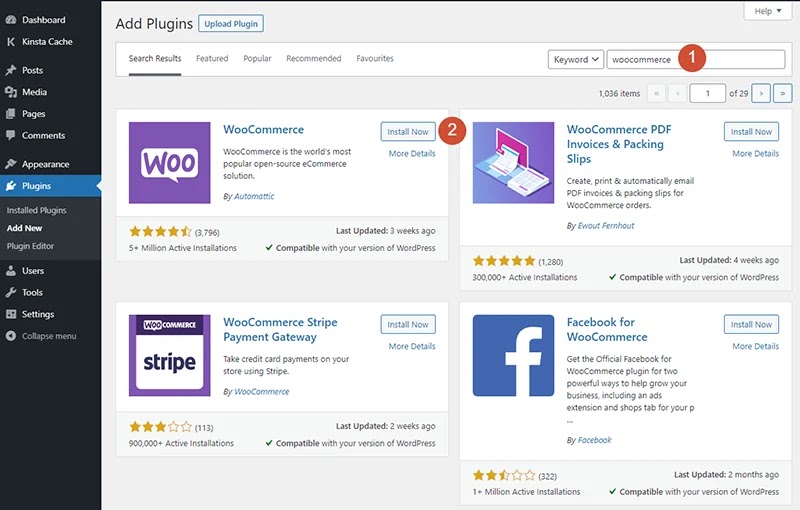With the rapid growth of e-commerce, setting up an online store has become easier than ever, especially when using WooCommerce – a powerful e-commerce plugin for WordPress. WooCommerce allows you to turn your WordPress website into a professional online store, helping you sell physical products, digital products, and even services.
In this article, we will guide you through installing WooCommerce, basic configuration, and creating products to start selling online on WordPress.
What is WooCommerce?
WooCommerce is a popular e-commerce plugin for WordPress that makes it easy to create and manage an online store. WooCommerce supports many features such as product management, shopping cart, payment and shipping. In addition, WooCommerce also allows you to extend its functionality through extensions such as online payment integration, automatic shipping and inventory management.
WooCommerce is a completely free solution, however, you can purchase additional extensions if you need more advanced features. With flexible customization capabilities and support from a large user community, WooCommerce is the top choice for small and medium-sized businesses looking to build a professional online store.
How to Install WooCommerce on WordPress
To get started, you need to install WooCommerce on your WordPress website. Here are the specific steps:
1. Go to your WordPress dashboard, select “Plugins” and click “Add New”.
2. Search for “WooCommerce” in the search bar and click “Install Now”.
3. Once the installation is complete, click “Activate” to activate WooCommerce on your website.
Once WooCommerce is activated, a setup wizard will appear, making it easy to configure the basic settings for your online store.

Basic Setup for WooCommerce
After installing WooCommerce, the wizard will walk you through the basic configuration steps. Here are the important settings you need to make:
1. Store Location Settings
In the first step, you’ll need to enter information about your store’s location, including country, address, and postal code. This is important because it affects your store’s tax and shipping settings.
2. Select Currency
WooCommerce lets you choose your store’s currency, such as VND (Vietnamese Dong), USD (US Dollar), or other currencies. Choose the currency that’s right for your customers.
3. Payment Method Configuration
WooCommerce supports multiple payment methods, including bank transfer, cash on delivery (COD), and e-payment gateways like PayPal, Stripe. You can choose the payment methods that suit your customers.
4. Delivery Configuration
WooCommerce offers shipping options like free shipping, flat-rate shipping, or shipping based on weight and distance. You can set up your shipping method depending on how you want to charge your customers.
5. Tax Settings
If your store requires taxes, you can configure them in the settings. WooCommerce allows you to set automatic tax rates based on the geographic location of your store and customers, or you can manually enter applicable tax rates.
Once you complete these settings, WooCommerce will automatically create the necessary pages like shop page, cart page, and checkout page.
How to Add Products to WooCommerce
Once you have finished configuring your store, the next step is to add products to WooCommerce. You can do this easily by following these steps:
1. Add New Products
Go to your WordPress dashboard, select “Products” and click “Add New”. Here you can enter a product title, description, and upload a product image.
2. Set Up Prices and Inventory
In the “Product Data” section, you can enter selling prices, promotional prices, and manage inventory. WooCommerce allows you to track inventory quantities, set options like in-stock, out-of-stock, and set up notifications when stock is low.
3. Add Categories and Tags
You can categorize your products by adding categories and tags. This makes it easy for customers to search for products by specific type and theme.
4. Optimize Product Images
Product images are an important factor in attracting customers. Make sure you use high-quality images and optimize their sizes to ensure that your page loads quickly.
Once you’re done adding products, click “Publish” to make the product available on your store.
Payment Method Integration
WooCommerce supports many flexible payment methods. You can integrate popular payment gateways such as PayPal, Stripe, or use extensions to add domestic payment gateways such as MoMo, VNPAY. To install these payment gateways, you just need to access “WooCommerce” > “Settings” > “Payments” and select the payment method you want to activate.
Order and Delivery Management
When a customer places an order on your store, WooCommerce sends an email notification and lets you manage orders directly from your WordPress dashboard. You can track order status, print invoices, and handle shipping for customers.
Additionally, WooCommerce supports integration with shipping services like ShipStation or local delivery providers, helping you automate the shipping process and track orders.
Advanced Features With WooCommerce Extensions
WooCommerce offers hundreds of extensions that help you extend the functionality of your online store. Some popular features include:
- **Subscription:** Helps you sell products on a subscription basis, such as monthly service packages.
- **WooCommerce Bookings:** Allow customers to book appointments directly on your website.
- **Inventory Management:** Track product inventory and set up notifications when products are running low.
- **Reporting and Analytics:** WooCommerce offers detailed reporting tools on sales, traffic, and product performance.
You can find and install these extensions from the WooCommerce Marketplace or from reputable third-party sources.
Online sales
WooCommerce is a powerful and flexible solution that makes it easy to build an online store on WordPress. With highly customizable features, flexible payment and shipping support, and unlimited extensibility, WooCommerce is a great choice for anyone looking to sell online.
Get started with WooCommerce today to get your store online and reach more customers.





